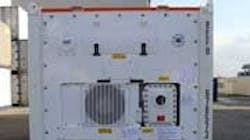Klinge offshore reefer container complies with explosives directive
Nearly two years after the Deepwater Horizon oil spill, demand for offshore refrigerated containers continues to rise. Klinge Corporation has responded to the demand and now offers an offshore refrigeration unit Model PFR-571 ZII-II that complies with guidelines included in ATEX Directive 94/9/EC level of Ex II 3 G, Group IIA for equipment used in potentially explosive atmospheres.
This sort of atmosphere is defined as an air mixture of flammable substances in the form of gases, vapors, mists, or dusts, that can ignite under certain conditions.
Since the company’s founding in 1984, Klinge Corp remains committed to providing safe and reliable products to those transporting dangerous chemicals or transporting goods in hazardous areas, such as oil rigs.
“Klinge Corp produced its first container for hazardous goods nearly 30 years ago and has applied their unique expertise in this area to the design of their ATEX-compliant unit PFR-571 ZII-II,” said Henrik Klinge, company president. ”Our PFR-571 ZII-II contains ATEX-certified components such as an electrical control box, cable glands, electric motors, solenoid valve, temperature switch, and pressure switch.
“Every component in the evaporator section is explosion-proof (since this section is in direct contact with the cargo area) and all external parts are explosion-proof,” he said. “The unit is also insulated with fire-resistant and CFC-free polyurethane foam between the evaporator and condenser section.”
The ATEX (or explosion-proof) Products Directive was developed by the European Commission of Enterprise and Industry and European Standardization Organizations to allow the free movement of ATEX equipment and protective systems throughout the European Union by removing the need for different national standards. Equipment and Products in each group are divided into categories based on the level of protection required.
Klinge Corp’s PFR-571 ZII-II is categorized as Group II, Category 3, meaning equipment is intended for use in areas in which explosive atmospheres caused by gases, vapors, mists, or air/dust mixtures are unlikely to occur or, if they do occur, are likely to do so only infrequently and for a short period only.
The PFR-571 ZII-II is also designed for safe operation in ATEX Zone 2 classified areas. These are places in which an explosive atmosphere consisting of a mixture with air of dangerous substances in the form of gas, vapor, or mist is not likely to occur in normal operation, but if it does occur, will persist for a short period only.
Adding to the safety of the ATEX Directive-compliant refrigeration unit is the EN12079 and DNV 2.7.1 certified offshore container to which the PFR-571 ZII-II refrigeration unit is mounted.
Offshore containers are used primarily in the oil and gas industry because of their ability to withstand the harsh environment and handling of the offshore industry. Due to the dangerous nature of the oil industry, these containers are subject to many more regulations and must undergo a strict certification process to ensure safety of personnel working on the oil rigs, oil tankers, as well as the environment.
For more information, e-mail [email protected] or visit www.klingecorp.com.
